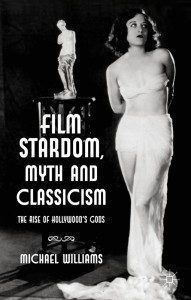Film Stardom, Myth and Classicism by Michael Williams (Palgrave Macmillan, 2013), 272 pages, ISBN: 978-0230355446 (hardback) £61
 About the reviewer: Dr Kirsty Fairclough-Isaacs, is Senior Lecturer in Media and Performance at the School of Arts and Media, University of Salford. Here research covers a cross-disciplinary field including Cultural Studies, Media Studies and Film Studies, with a particular focus on celebrity, and stardom, popular comedy and gender, feminism, popular music and contemporary Hollywood. Recent publications include: “Prime Time: Jane Fonda, ‘Appropriate’ Ageing and the Re-Making of a Hollywood Persona’ in Bolton and Lobalzo-Wright (eds), Lasting Screen Stars: Personas that Endure and Images that Fade (Palgrave, 2015); Fairclough, Halligan, & Edgar (eds), The Music Documentary: Acid Rock to Electropop (Routledge, 2013)
About the reviewer: Dr Kirsty Fairclough-Isaacs, is Senior Lecturer in Media and Performance at the School of Arts and Media, University of Salford. Here research covers a cross-disciplinary field including Cultural Studies, Media Studies and Film Studies, with a particular focus on celebrity, and stardom, popular comedy and gender, feminism, popular music and contemporary Hollywood. Recent publications include: “Prime Time: Jane Fonda, ‘Appropriate’ Ageing and the Re-Making of a Hollywood Persona’ in Bolton and Lobalzo-Wright (eds), Lasting Screen Stars: Personas that Endure and Images that Fade (Palgrave, 2015); Fairclough, Halligan, & Edgar (eds), The Music Documentary: Acid Rock to Electropop (Routledge, 2013)
The canon of texts on Classical Hollywood and stardom is vast. Since Richard Dyer (1979) first explored the star phenomenon and asked why audiences’ experiences of cinema were so heavily influenced by their perception of stars, there have been dozens of books published that develop these ideas or indeed argue against them.
Yet surprisingly little attention has been paid to the area that Michael Williams’s book explores: the idea that the origins of screen stardom developed from the myths and iconography of ancient Greece and Rome.
 Williams’ book concerns itself with the ways in which classicism was instrumental in facilitating the cultural prestige of Hollywood. It explores with some precision, the post World War 1 period in Hollywood and how it utilised the aura of antiquity and the enduring appeal of its mythological gods as a template for stardom. Indeed, Williams charts how the iconography and attributes of classical figures became the basis for Hollywood’s development of its star system. He argues that the physical and temporal elusiveness of these figures was the foundation upon which Hollywood built its industry. Through highly engaging research, Williams explores how the industry and most interestingly, fan magazines such as Photoplay manufactured desire around its key players such as Greta Garbo and Rudolph Valentino.
Williams’ book concerns itself with the ways in which classicism was instrumental in facilitating the cultural prestige of Hollywood. It explores with some precision, the post World War 1 period in Hollywood and how it utilised the aura of antiquity and the enduring appeal of its mythological gods as a template for stardom. Indeed, Williams charts how the iconography and attributes of classical figures became the basis for Hollywood’s development of its star system. He argues that the physical and temporal elusiveness of these figures was the foundation upon which Hollywood built its industry. Through highly engaging research, Williams explores how the industry and most interestingly, fan magazines such as Photoplay manufactured desire around its key players such as Greta Garbo and Rudolph Valentino.
What is striking about the book, and one of the reasons it is such a rich text, is that it is keen to highlight that the fragments of stardom that it explores are connected not only to an obviously cinematic phenomenon, but to a whole host of other cultural forms such as archaeology, literature, art history, architecture and naturally, classical reception studies. It signals to the reader that classicism is not the universal construct it is often considered to be, but that it is a indefinable, often contradictory and indeed nebulous construct.
What is particularly noteworthy in Williams’s book is the way in which it keenly elucidates the ways in which the ancient past has been adapted and adopted to serve the needs of the present, and in doing so points out how a range of different media have been utilised to make the past seem altogether more enchanting.
The book uses a range of texts as its basis for analysis from major releases such as Ben-Hur: A Tale of the Christ (Fred Niblo, 1925) and Flesh and the Devil (Clarence Brown, 1926) to explain how the tenets of classicism enabled Hollywood to transform actors into icons. With particular significance is the analysis of an article from an early issue of Photoplay magazine, ‘Olympus moves to Hollywood’ (1928) which to began to transform very well-known actors into icons for a modern age, effectively creating a model of stardom that still exists in popular culture today.
This magazine, like the industry itself, imagined Hollywood’s stars to be modern deities who were exceptional in terms of their beauty, physicality and indeed intelligence, almost surpassing their supposed classical counterparts. Williams shows how this rhetoric became so normalised in Hollywood that the uses of the terms ‘gods’ and ‘goddesses’ became accepted terms with which to describe its acting employees.
This is an extremely well written and engaging book, which is meticulous in its pursuit of offering the reader enlightening examples of the ways in which Hollywood worked to create parallels between its stars and the classical antecedents.
This is a complex area of film studies and the book is engaging, if at times challenging for the undergraduate reader. Indeed, Film Stardom, Myth and Classicism inevitably raises many more questions that it is capable of answering, but it is a very welcome addition to an ever-growing field.
Dr Kirsty Fairclough-Isaacs
Michael Williams' essay about his research can be read here. http://bufvc.ac.uk/articles/gods-and-idols